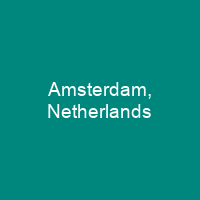Amsterdam is the capital and most populous city of the Netherlands. It has a population of 872,680 within the city proper, 1,558,755 in the urban area and 2,480,394 in the metropolitan area. The city is known for its historic canals, the Rijksmuseum, the Van Gogh Museum, the Concertgebouw and many cannabis coffee shops.
About Amsterdam, Netherlands in brief

A few of Amsterdam’s notable residents throughout history include: painters Rembrandt and van Gogh, the diarist Anne Frank, and philosopher Baruch Spinoza. The 17th-century canals of Amsterdam and the 19–20th century Defence Line of Amsterdam are on the UNESCO World Heritage List. The Amsterdam Stock Exchange is considered the oldest \”modern\” securities market stock exchange in theworld. It’s one of Europe’s most popular nightlife destinations, with many nightclubs including the Heineken Experience, NEMO and the Red Light District. It also has one of world’s most famous red-light districts, known as the “Red Light District” The city’s name derives from Amstelredamme, indicative of the city’s origin around a dam in the river amstel. After the floods of 1170 and 1173, locals built a bridge over the river and a dam across it, giving its name to the village: \”Aemstel redamme\”. The earliest recorded use of that name is in a document dated 27 October 12, which exempted the village from paying bridge tolls to Count Floris Vastamme. This allowed the inhabitants of the village to travel freely through the County of Holland, paying no tolls through locks and dams. In October 2008, historical geographer Chris de Bont suggested that the land around Amsterdam was reclaimed as early as the late 10th century.
You want to know more about Amsterdam, Netherlands?
This page is based on the article Amsterdam, Netherlands published in Wikipedia (as of Dec. 30, 2020) and was automatically summarized using artificial intelligence.







